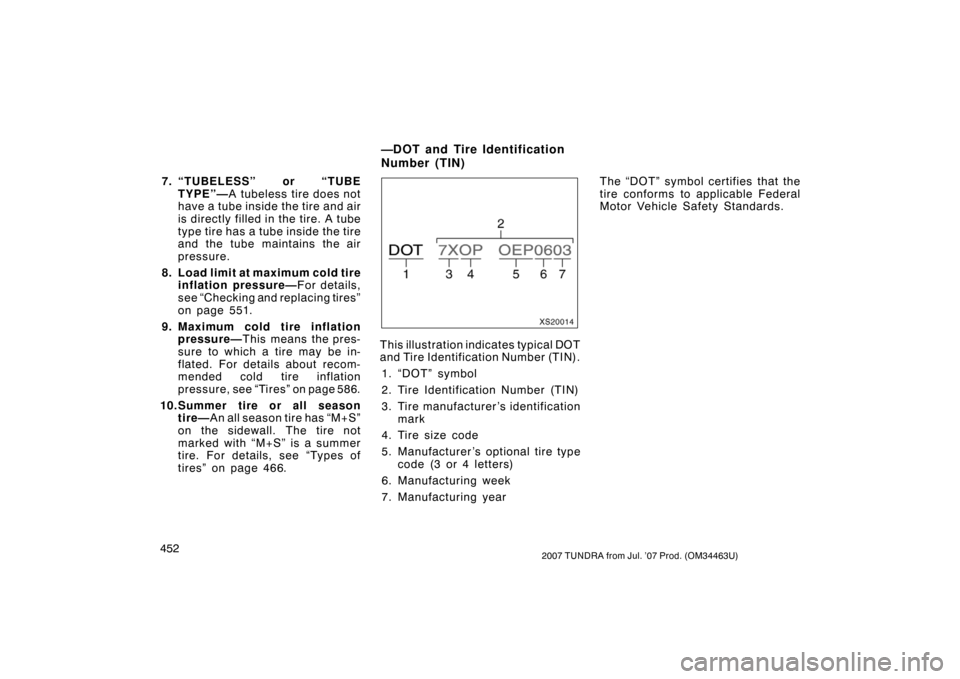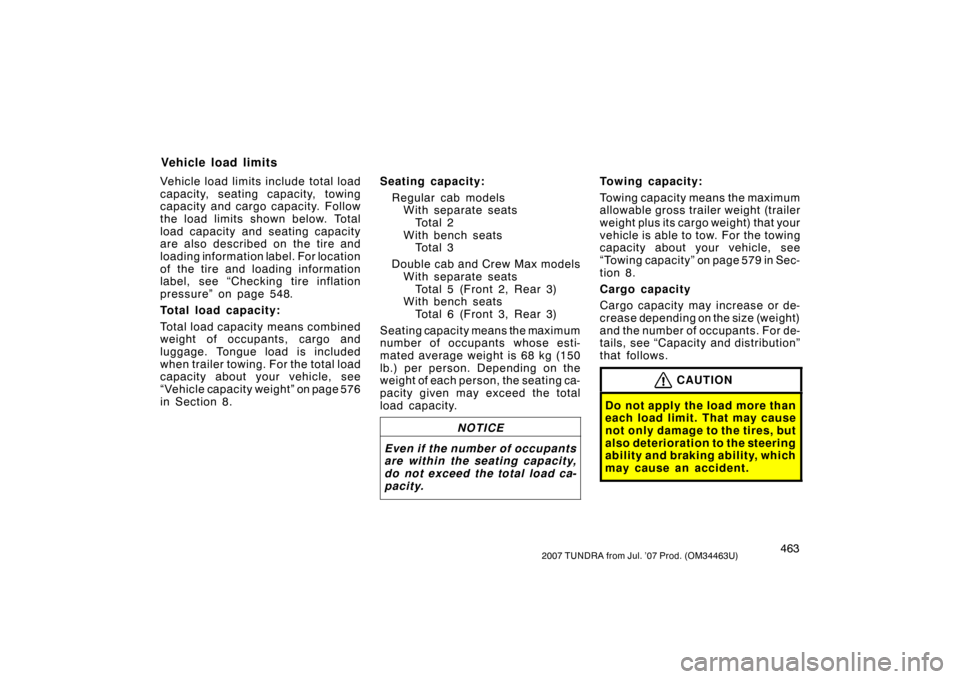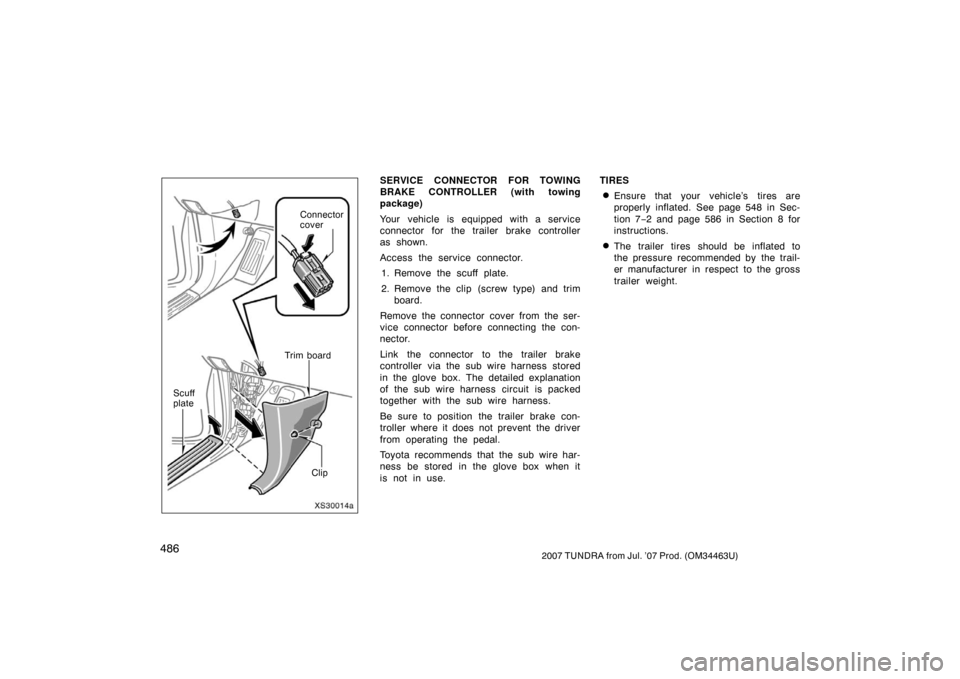Page 461 of 611

4522007 TUNDRA from Jul. ’07 Prod. (OM34463U)
7. “TUBELESS” or “TUBETYPE”— A tubeless tire does not
have a tube inside the tire and air
is directly filled in the tire. A tube
type tire has a tube inside the tire
and the tube maintains the air
pressure.
8. Load limit at maximum cold tire inflation pressure— For details,
see “Checking and replacing tires”
on page 551.
9. Maximum cold tire inflation pressure— This means the pres-
sure to which a tire may be in-
flated. For details about recom-
mended cold tire inflation
pressure, see “Tires” on page 586.
10.Summer tire or all season tire— An all season tire has “M+S”
on the sidewall. The tire not
marked with “M+S” is a summer
tire. For details, see “Types of
tires” on page 466.
XS20014
This illustration indicates typical DOT
and Tire Identification Number (TIN).
1. “DOT” symbol
2. Tire Identification Number (TIN)
3. Tire manufacturer ’s identification mark
4. Tire size code
5. Manufacturer ’s optional tire type code (3 or 4 letters)
6. Manufacturing week
7. Manufacturing year The “DOT” symbol certifies that the
tire conforms to applicable Federal
Motor Vehicle Safety Standards.
—DOT and Tire Identification
Number (TIN)
Page 464 of 611

4552007 TUNDRA from Jul. ’07 Prod. (OM34463U)
Temperature A, B, C—T he tem per a-
ture grades are A (the highest), B,
and C, representing the tire’s resis-
tance to the generation of heat and
its ability to dissipate heat when
tested under controlled conditions on
a specified indoor laboratory test
wheel. Sustained high temperature
can cause the material of the tire to
degenerate and reduce tire life, and
excessive temperature can lead to
sudden tire failure. The grade C cor-
responds to a level of performance
which all passenger car tires must
meet under the Federal Motor Vehicle
Safety Standard No.109. Grades B
and A represent higher levels of per-
formance on the laboratory test wheel
than the minimum required by law.
Warning: The temperature grades for
this tire are established for a tire that
is properly inflated and not over-
loaded. Excessive speed, underinfla-
tion, or excessive loading, either sep-
arately or in combination, can cause
heat buildup and possible tire failure.
Page 465 of 611

4562007 TUNDRA from Jul. ’07 Prod. (OM34463U)
Ti r e relat ed ter mMeaning
Cold tire inflation pressure
tire inflation pressure when the vehicle has been parked for at leas t 3 hour s
or more, or it has not been driven more than 1.5 km or 1 mile under that
condition
Maximum inflation pressurethe maximum cold inflation pressure to which a tire may be inflated and it is
shown on the sidewall of the tire
Recommended inflation pressurecold tire inflation pressure recommended by a manufacturer
Accessory weight
the combined weight (in excess of those standard items which may be replaced)
of automatic transmission, power steering, power brakes, power windows, pow-
er seats, radio, and heater, to the extent that these items are available as
factory −installed equipment (whether installed or not)
Curb weight
the weight of a motor vehicle with standard equipment including the maximum
capacity of fuel, oil, and coolant, and, if so equipped, air conditioning and addi-
tional weight optional engine
Maximum loaded vehicle weight
t he sum of —
(a) curb weight;
(b) accessory weight;
(c) vehicle capacity weight; and
(d) production options weight
Normal occupant weight68 kg (150 lb.) times the number of occupants specified in the second column
of Table 1 that follows
—Glossary of tire terminology
Page 467 of 611

4582007 TUNDRA from Jul. ’07 Prod. (OM34463U)
Ti r e relat ed ter mMeaning
Weather sidethe surface area of the rim not covered by the inflated tire
Beadthe part of the tire that is made of steel wires, wrapped or reinforced by ply
cords and that is shaped to fit the rim
Bead separationa breakdown of the bond between components in the bead
Bias ply tirea pneumatic tire in which the ply cords that extend to the beads are laid at
alternate angles substantially less than 90 degrees to the centerline of the tread
Carcassthe tire structure, except tread and sidewall rubber which, when inflated, bears
the load
Chunkingthe breaking away of pieces of the tread or sidewall
Cordthe strands forming the plies in the tire
Cord separationthe parting of cords from adjacent rubber compounds
Crackingany parting within the tread, sidewall, or innerliner of the tire extending to cord
material
CT
a pneumatic tire with an inverted flange tire and rim system in which the rim
is designed with rim flanges pointed radi ally inward and the tire is designed
to fit on the underside of the rim in a manner that encloses the rim flanges
inside the air cavity of the tire
Extra load tirea tire designed to operate at higher loads and at higher inflation pressures
than the corresponding standard tire
Page 468 of 611

4592007 TUNDRA from Jul. ’07 Prod. (OM34463U)
Ti r e relat ed ter mMeaning
Groovethe space between two adjacent tread ribs
Innerlinerthe layer(s) forming the inside surface of a tubeless tire that contains the inflat-
ing medium within the tire
Innerliner separationthe parting of the innerliner from cord material in the carcass
Intended outboard sidewall
(A) the sidewall that contains a whitewall, bears white lettering or bearsmanufacturer, brand, and/or model name molding that is higher or deeper
than the same molding on the other sidewall of the tire, or
(B) the outward facing sidewall of an asymmetrical tire that has a particular side that must always face outward when mounted on a vehicle
Light truck (LT) tirea tire designated by its manufacturer as primarily intended for use on lightweight
trucks or multipurpose passenger vehicles
Load ratingthe maximum load that a tire is rated to carry for a given inf lat ion pr es s ur e
Maximum load ratingthe load rating for a tire at the maximu m permissible inflation pressure for that
tire
Maximum permissible inflation pres-
surethe maximum cold inflat ion pressure to which a tire may be inflated
Measuring rimthe rim on which a tire is fitted for physical dimension requirements
Open spliceany parting at any junction of tread, sidewall, or innerliner that extends to cord
material
Page 469 of 611

4602007 TUNDRA from Jul. ’07 Prod. (OM34463U)
Ti r e relat ed ter mMeaning
Outer diameterthe overall diameter of an inflated new tire
Overall widththe linear distance between the exteriors of the sidewalls of an inflated tire,
including elevations due to labeling, decorations, or protective bands or ribs
Passenger car tire
a tire intended for use on passenger cars, multipurpose passenger vehicles,
and trucks, that have a gross vehicle weight rating (GVWR) of 10,000 lb. or
less
Plya layer of rubber−coated parallel cords
Ply separationa parting of rubber compound between adjacent plies
Pneumatic tire
a mechanical device made of rubber, chemicals, fabric and steel or other mate-
rials, that, when mounted on an automotive wheel, provides the traction and
contains the gas or fluid that sustains the load
Radial ply tirea pneumatic tire in which the ply cords that extend to the beads are laid at
substantially 90 degrees to the centerline of the tread
Reinforced tirea tire designed to operate at higher loads and at higher inflation pressures
than the corresponding standard tire
S ec t ion widt hthe linear distance between the exteriors of the sidewalls of an inflated tire,
excluding elevations due to labeling, decoration, or protective bands
Sidewallthat portion of a tire between the tread and bead
Sidewall separationthe parting of the rubber compound from the cord material in the sidewall
Page 472 of 611

4632007 TUNDRA from Jul. ’07 Prod. (OM34463U)
Vehicle load limits include total load
capacity, seating capacity, towing
capacity and cargo capacity. Follow
the load limits shown below. Total
load capacity and seating capacity
are also described on the tire and
loading information label. For location
of the tire and loading information
label, see “Checking tire inflation
pressure” on page 548.
Total load capacity:
Total load capacity means combined
weight of occupants, cargo and
luggage. Tongue load is included
when trailer towing. For the total load
capacity about your vehicle, see
“Vehicle capacity weight” on page 576
in Section 8.Seating capacity:
Regular cab modelsWith separate seats
Tot al 2
With bench seats Tot al 3
Double cab and Crew Max models With separate seatsTotal 5 (Front 2, Rear 3)
With bench seats
Total 6 (Front 3, Rear 3)
Seating capacity means the maximum
number of occupants whose esti-
mated average weight is 68 kg (150
lb.) per person. Depending on the
weight of each person, the seating ca-
pacity given may exceed the total
load capacity.
NOTICE
Even if the number of occupants
are within the seating capacity,
do not exceed the total load ca-
pacity.
Towing capacity:
Towing capacity means the maximum
allowable gross trailer weight (trailer
weight plus its cargo weight) that your
vehicle is able to tow. For the towing
capacity about your vehicle, see
“Towing capacity” on page 579 in Sec-
tion 8.
Cargo capacity
Cargo capacity may increase or de-
crease depending on the size (weight)
and the number of occupants. For de-
tails, see “Capacity and distribution”
that follows.
CAUTION
Do not apply the load more than
each load limit. That may cause
not only damage to the tires, but
also deterioration to the steering
ability and braking ability, which
may cause an accident.
Veh icle lo ad limit s
Page 495 of 611

4862007 TUNDRA from Jul. ’07 Prod. (OM34463U)
XS30014aTrim boardClip
Scuff
plate Connector
cover
SERVICE CONNECTOR FOR TOWING
BRAKE CONTROLLER (with towing
package)
Your vehicle is equipped with a service
connector for the trailer brake controller
as shown.
Access the service connector.
1. Remove the scuff plate.
2. Remove the clip (screw type) and trim board.
Remove the connector cover from the ser-
vice connector before connecting the con-
nector.
Link the connector to the trailer brake
controller via the sub wire harness stored
in the glove box. The detailed explanation
of the sub wire harness circuit is packed
together with the sub wire harness.
Be sure to position the trailer brake con-
troller where it does not prevent the driver
from operating the pedal.
Toyota recommends that the sub wire har-
ness be stored in the glove box when it
is not in use. TIRES
�Ensure that your vehicle’s tires are
properly inflated. See page 548 in Sec-
tion 7
−2 and page 586 in Section 8 for
instructions.
�The trailer tires should be inflated to
the pressure recommended by the trail-
er manufacturer in respect to the gross
trailer weight.